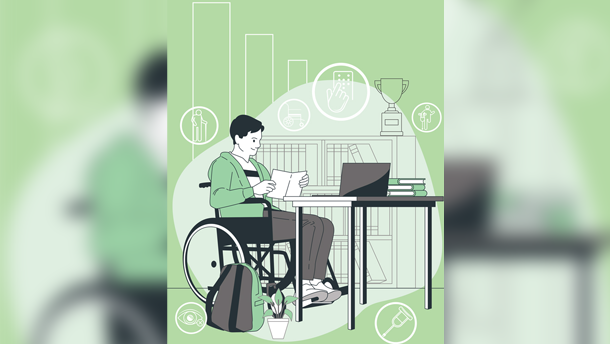
As businesses continue to evolve in an increasingly diverse world, those that prioritise disability inclusion and accessibility will see enhanced innovation, improved employee retention, and stronger competitive advantages in the global marketplace.
Here’s a startling fact: up to one in four people have a disability at any given time. This includes many people in our workplaces and those who seek to make meaningful contributions, both for their own careers and in their communities.
Disabilities vary greatly, ranging from conditions people are born with to those that are acquired later in life. Disabilities can be physical, sensory, cognitive, psychological, or neurological in nature. Some last for a lifetime and some are temporary. Many disabilities are hidden—up to 70 per cent are not apparent to a casual observer—especially those that are related to chronic health and mental health conditions.
Even though there is such a high percentage of people with disabilities, they experience far lower success in the workplace, both in entry-level jobs and, far more so, in leadership positions.
This represents an area for growth in our global marketplace and our communities, one that is often overlooked in our strategic planning for both developing workplace talent and reaching a broader customer base. In an era where retaining high-performing employees is a strategic imperative, many organisations are still struggling with this crucial aspect: Accessibility for all employees, including those with disabilities.
This accessibility gap results in lost opportunity not just for individual employees, but for entire industries that seek to reach clients and customers, many of whom also have disabilities and need accessible products and services.
But accessibility is the endpoint, not the starting point. Recent research reveals that the greatest obstacle to accessibility is not technological or financial—it is the need to build an accessibility mindset. Accessibility mindset is more than a checklist of to-do items—it reflects our understanding of disability and how we plan for accommodations and flexibility in our work. Negative attitudes about disability have a cumulative and demoralising effect on employees:
“The hardest part wasn’t dealing with my disability. It was dealing with people’s assumptions about what I couldn’t do,” shared one professional, highlighting the critical need to challenge preconceptions. Starting at “no” is a common experience for disabled people seeking accessibility at work. When an accommodations or accessibility request appears, here are some typical responses:’
“If we say ‘yes’ to this, it will open the floodgates for more requests.” “I can’t give access to that because I don’t know how.” “Accommodations make it unfair for everyone else.”
“That’s a lot of money to spend on one person.” These reactions reflect a deficit approach to accessibility: framing possibilities for disabled employees around the limitations and costs instead of the value of potential and organisationwide benefit. Consider these reframed responses: “How can implementing this request help us build stronger policies?” “Where can we build organisational capacity and scale our processes?” “What does this accommodation request tell us about accessibility in our business?” “How is this RoI measured in retention and future recruitment?” Notice that each of these is now a question—a place of curiosity—instead of a flat-out denial based on negative assumptions. Accommodations and accessibility are rarely about serving one person or one need: they are about setting up your organisation for success both now and in the future. Asking good questions will compound the value of each accessibility decision for you and your organisation.
Three pillars of effective accessibility
Working on accessibility may take time, but every step along the way is important. It is like building muscle—each flex gives us practice lifting a heavier weight—making us stronger and more resilient for future challenges, which become opportunities for greater efficiency and effectiveness.
Here are three key elements that organisations must embrace for long-term accessibility:
Benefits of workplace flexibility
A recent LinkedIn poll revealed that over half of professionals have experienced significant career impacts due to health issues. Embedded workplace flexibility options reduce the need for cumbersome and individual accommodation requests.
For example
Moving forward
The case for disability inclusion is compelling and attainable. Organisations that create truly inclusive spaces report benefits in creativity, adaptability, and innovation—and become places where the strongest talent wants to stay and thrive. And yet as a manager or leader, it can be difficult to figure out where to start. Sometimes we are unsure of what to say or how to talk about disability in the workplace. Sometimes it feels like we are only being reactive, not proactive, and therefore, wasting time and energy that could be used more effectively.
At both an individual and team level, here is a three-step framework for organizations looking to improve their disability inclusion practices:
1. Acknowledge knowledge gaps and where you need more information about accessibility.
2. Ask specific questions about needed accommodations and ways technology can help.
3. Focus on solution-oriented approaches that build capacity throughout your organisation.
As businesses continue to evolve in an increasingly diverse world, those that prioritise disability inclusion and accessibility will see enhanced innovation, improved employee retention, and stronger competitive advantages in the global marketplace.
Log In or become an AIMA member to read more articles
